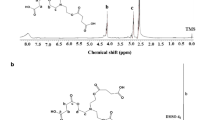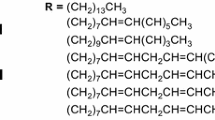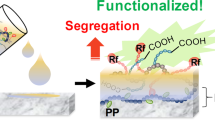Summaries
A novel N-halamine monomer has been prepared which can be copolymerised with a commercial water-borne acrylic polyol and a commercial isocyanate to produce a polyurethane coating which can be applied to a broad variety of surfaces. After curing, the coating can be chlorinated with a source of free chlorine, such as bleach, to render it biocidal. Once the coating loses its chlorine loading, and hence its biocidal activity, regeneration is possible by further exposure to free chlorine. In one experimental observation a coating on a wall retained its biocidal activity for more than six months. The biocidal coating should have many applications, for example, in medical facilities, in food preparation areas, in the prevention of biofouling in aqueous and humid environments, etc.
Résumé
Un nouveau monomère à la n-halamine a été préparé qui peut être copolymérisé avec un polyol acrylique hydrodiluable commercial et un isocyanate commercial afin de produire un revêtement polyuréthanique qui peut être appliqué à une large variété de surfaces. Après séchage le revêtement peut être chloré en utilisant une source de chlore libre, telle que l’eau de Javel, pour le rendre biocide. Une fois que le revêtement perd sa charge de chlore, et donc son activité biocide, la régénération est possible par le moyen d’une autre exposition au chlore libre. Au cours d’une certaine observation d’expérience on a noté que le revêtement d’un mur a retenu son activité biocide pendant plus de six mois. Le revêtement biocide devrait avoir de nombreuses applications, par example, dans les établissements médicaux, dans les lieux de préparation des produits alimentaires, dans le domaine de la prévention de la biocontamination des environnements humides ou aqueux, etc.
Zusammenfassung
Wir haben einen neuartigen N-Balaminmonomer hergestellt, der durch ein handelsübliches acrylisches Polyol und ein Isocyanat copolymerisiert werden kann. Der so erhaltene Lack kann auf eine weite Reihe von Oberflächen aufgetragen werden. Nach dem Härteprozess kann der Lack mit einem Produzenten von freiem Chlor wie Bleiche chloriniert werden, um die Biozidwirkung zu aktivieren. Da der Lack mit der Zeit seinen Chlorgehalt verliert und damit seine Wirkungskraft, kann diese Behandlung kann nach Bedarf wiederholt werden. Eines unserer Experimente zeigte dass der Lack seine Biozidwirkung für über sechs Monate beibehalten kann. Dieser Biozidlack dürfte vielfältig Anwendung finden, z. B. in Krankenhäusern, Küchen, zum Verhindern von Pilzbefall in feuchten Räumen und so weiter.
Similar content being viewed by others
References
Worley S D and D E Williams, ‘Halamine water disinfectants’,Crit Rev Environ Contrl,18, 133, 1988;
Worley S D and G Sun, ‘Biocidal polymers’,Trends Polym Sci,4, 364, 1996
Emerson D W, D T Shea and E M Sorensen, ‘Functionally-modified poly-styrene-divinylbenzene: Preparation, characterisation and biocidal action’,Ind Eng Chem Prod Res Dev,17, 269, 1978;
Emerson D W, ‘Polymer-bound active chlorine: Disinfection of water in a flow system: Polymer supported reagents. 5’,Ind Eng Chem Res,29, 448, 1990;
Emerson D W, ‘Slow release of active chlorine and bromine from styrene-divinylbenzene copolymers bearing N,N-dichlorosulfonamide, N-chloro-N-alkylsulfonamide, and N-bromo-N-alkylsulfonamide functional groups. Polymer supported reagents. 6’,Ind Eng Chem Res,30, 2426, 1991;
Bogoczek R and E K Balawejder, ‘N-monohalogeno- and N,N-dihalogeno-poly(styrene-co-divinylbenzene)sulfonamides (P-SO2NXNa, P-SO2NX2)’,Polym Commun,27, 286, 1986;
Bogoczek R and E K Balawejder, “Studies on a macromolecular dichloramine — the N,N-dichloropoly(styrene-co-divinylbenzene)sulfonamide,Angew Makromolec Chem,169, 119, 1989
Kanazawa A, T Ikeda and T Endo, ‘Polymeric phosphonium salts as a novel class of cationic biocides. III. Immobilization of phosphonium salts by surface photografting and antibacterial activity of the surface-treated polymer films’,J Polym Sci. Part A: Polym Chem,31, 1467, 1993
Lambert J L, G T Fina and L R Fina, ‘Preparation and properties of triiodide, pentaiodide, and hepatiodide: Quaternary ammonium strong base anion-exchange resin disinfectants’,Ind Eng Chem Prod Res Dev,19, 256, 1980;
Hazziza-Laskar J, N Nurdin, G Helary and G Sauvet, ‘Biocidal polymers active by contact. I. Synthesis of polybutadiene with pendant quaternary ammonium groups’,J Appl Polym Sci,50, 651, 1993
Sun G and X Xu, ‘Durable and regenerable antibacterial finishing of fabrics: Fabric properties’,Text Chem Col,31, 21, 1999
Sun Y, T Y Chen, S D Worley and G Sun, “Novel refreshable N-halamine polymeric biocides containing imidazolidin-4-one derivatives’,J Polym Sci. Part A: Polym Chem,39, 3073, 2001
Lin J, C Winkelmann, S D Worley, R M Broughton and J F Williams, ‘Antimicrobial treatment of nylon’,J Appl Polym Sci,81, 943, 2001
Lin J, C Winkelmann, S D Worley, J Kim, C I Wei, U Cho, R M Broughton, J L Santiago and J F Williams, “Biocidal polyester’,J Appl Polym Sci,85, 177, 2002
Elrod D B, J G Figlar, S D Worley, R M Broughton, J R Bickert, J L Santiago and J F Williams, ‘A novel biocidal elastomer’,Rub Chem Tech,74, 331, 2001
Eknoian M W, S D Worley, J Bickert and J F Williams, ‘Novel antimicrobial N-halamine polymer coatings generated by emulsion polymerisation”,Polym,40, 1367, 1999
Sun G, W B Wheatley and S D Worley, ‘A new cyclic N-halamine biocidal polymer’,Ind Eng Chem Res,33, 168, 1994
Sun G, L C Allen, E P Luckie, W B Wheatley and S D Worley, ‘Disinfection of water by N-halamine biocidal polymers’,Ind Eng Chem Res,34, 4106, 1995
Sun G, T Y Chen, W B Wheatley and S D Worley, ‘Preparation of novel biocidal N-halamine polymers’,J Bioact Compat Polym,10, 135, 1995
Sun G, T Y Chen, M S Habercom, W B Wheatley and S D Worley, ‘Performance of a new polymeric water disinfectant’,J Amer Water Res Assoc,32, 793, 1996
Panangala V S, L Liu, G Sun, S D Worley and A Mitra, ‘Inactivation of rotavirus by new polymeric water disinfectants’,J Virol Meth,66, 263, 1997
Author information
Authors and Affiliations
Corresponding author
Rights and permissions
About this article
Cite this article
Worley, S., Li, F., Wu, R. et al. A novel N-halamine monomer for preparing biocidal polyurethane coatings. Surface Coatings International Part B: Coatings Transactions 86, 273–277 (2003). https://doi.org/10.1007/BF02699499
Issue Date:
DOI: https://doi.org/10.1007/BF02699499




